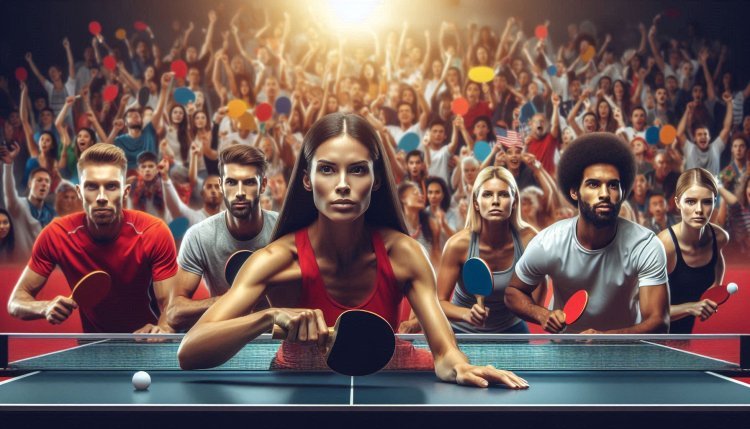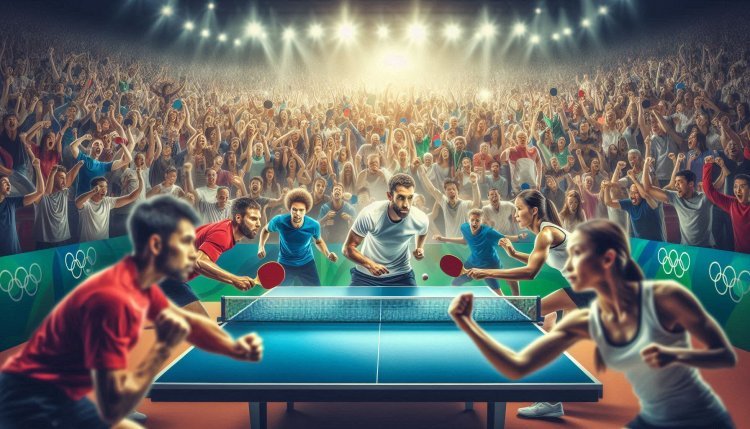The Rise of Olympic Ping Pong: A Thrilling Sport for the World Stage
Ping pong, also known as table tennis, has come a long way from its humble beginnings as a parlor game in Victorian England. Today, it is a globally recognized sport and an integral part of the Olympic Games. Olympic ping pong has captured the hearts of millions
Ping pong, also known as table tennis, has come a long way from its humble beginnings as a parlor game in Victorian England. Today, it is a globally recognized sport and an integral part of the Olympic Games. Olympic ping pong has captured the hearts of millions, combining lightning-fast reflexes, strategic gameplay, and intense competition. In this article, we’ll explore the history of Olympic ping pong, its rules, notable players, and why it continues to be one of the most exciting events in the world of sports.
The History of Ping Pong in the Olympics
Ping pong made its Olympic debut at the 1988 Seoul Games, and since then, it has become a staple of the Summer Olympics. The International Table Tennis Federation (ITTF) worked tirelessly to get the sport recognized by the International Olympic Committee (IOC), and their efforts paid off. The inclusion of ping pong in the Olympics has helped elevate the sport’s profile, attracting new fans and inspiring a new generation of players.
The Olympic ping pong competition features both singles and team events for men and women. Over the years, the format has evolved to keep up with the sport’s growing popularity and to ensure fair and exciting matches. The introduction of new rules, such as the 11-point scoring system (replacing the traditional 21-point system), has made the game faster and more dynamic, perfect for the Olympic stage.

Why Olympic Ping Pong is So Exciting
Olympic ping pong is a spectacle of speed, precision, and strategy. The sport requires players to have exceptional hand-eye coordination, quick reflexes, and the ability to think several moves ahead. Matches are often decided by split-second decisions, making it a thrilling experience for both players and spectators.
One of the most captivating aspects of Olympic ping pong is the diversity of playing styles. Players from different countries bring their unique techniques and strategies to the table, creating a fascinating blend of offensive and defensive gameplay. From powerful smashes to delicate spins, every match is a showcase of skill and creativity.
The intensity of Olympic ping pong is further amplified by the high stakes. For many players, competing in the Olympics is the pinnacle of their careers. The pressure to perform on the world stage, combined with the pride of representing their country, makes every point crucial. This emotional depth adds another layer of excitement to the sport.
Notable Olympic Ping Pong Players
Over the years, Olympic ping pong has produced some of the most iconic athletes in the world of table tennis. These players have not only dominated the sport but also inspired millions with their dedication and passion.
-
Ma Long (China)
Known as the "Dragon," Ma Long is widely regarded as one of the greatest ping pong players of all time. He has won multiple Olympic gold medals, including the men’s singles title at both the 2016 Rio Olympics and the 2020 Tokyo Olympics. His combination of power, precision, and consistency has made him a force to be reckoned with. -
Ding Ning (China)
Ding Ning is one of the most successful female ping pong players in Olympic history. She won gold in the women’s singles event at the 2016 Rio Olympics and has been a key player in China’s dominance of the sport. Her aggressive playing style and mental toughness have earned her a place among the legends of the game. -
Jan-Ove Waldner (Sweden)
Often referred to as the "Mozart of Table Tennis," Jan-Ove Waldner is a pioneer of Olympic ping pong. He won the men’s singles gold medal at the 1992 Barcelona Olympics and is celebrated for his innovative playing style and longevity in the sport. -
Ai Fukuhara (Japan)
Ai Fukuhara, also known as "Ai-chan," is a beloved figure in the world of ping pong. Although she retired in 2018, her contributions to the sport and her performances at the Olympics have left a lasting impact. She was a key player in Japan’s rise as a table tennis powerhouse.
The Rules of Olympic Ping Pong
Understanding the rules of Olympic ping pong can enhance your appreciation of the sport. Here are some key rules and regulations:
-
Scoring System: Olympic ping pong matches are played using an 11-point scoring system. The first player to reach 11 points wins the game, but they must win by a margin of at least 2 points.
-
Best of Seven: In singles events, matches are typically played as a best-of-seven series. The first player to win four games wins the match.
-
Serve Rules: Players must toss the ball at least 6 inches in the air before hitting it, and the ball must bounce once on their side of the table before crossing the net. Serves alternate every two points.
-
Let Serves: If the ball touches the net during a serve but still lands in the correct service area, it is called a "let," and the serve is retaken.
-
Doubles Play: In team events, players must alternate hits, and the serve must go diagonally from the right side of the server’s court to the right side of the receiver’s court.
The Global Appeal of Olympic Ping Pong
One of the reasons Olympic ping pong has become so popular is its accessibility. Unlike many other sports, ping pong requires minimal equipment and can be played almost anywhere. This has helped the sport gain a foothold in countries around the world, from China and Japan to Germany and the United States.
China has been the dominant force in Olympic ping pong, winning the majority of gold medals since the sport’s introduction. However, other countries are catching up, and the competition is becoming more balanced. Nations like Japan, South Korea, and Germany have invested heavily in developing their ping pong programs, producing world-class players who can challenge China’s supremacy.
The global appeal of Olympic ping pong is also reflected in its fan base. The sport has a dedicated following, with millions of fans tuning in to watch the Olympics and other major tournaments. Social media has played a significant role in growing the sport’s popularity, with players and fans sharing highlights, tips, and behind-the-scenes content.
The Future of Olympic Ping Pong
As we look ahead to future Olympic Games, the future of ping pong looks bright. The ITTF continues to innovate, introducing new technologies and formats to keep the sport fresh and engaging. For example, the use of advanced camera angles and instant replay has enhanced the viewing experience, allowing fans to appreciate the skill and precision of the players.
There is also a growing emphasis on inclusivity and diversity in Olympic ping pong. Efforts are being made to encourage more women and players from underrepresented regions to take up the sport. This will not only help grow the sport but also ensure that it remains a true global competition.

How to Get Involved in Ping Pong
Inspired by the excitement of Olympic ping pong? Here are some tips to get started:
-
Find a Local Club: Many communities have ping pong clubs or recreational centers where you can play and learn from others.
-
Invest in Equipment: All you need is a paddle, a ball, and a table. Look for beginner-friendly equipment to get started.
-
Practice Regularly: Like any sport, ping pong requires practice. Focus on developing your basic skills, such as serving, forehand, and backhand strokes.
-
Watch and Learn: Study the techniques of top players by watching Olympic matches and tutorials online.
-
Have Fun: Ping pong is a social and enjoyable sport. Whether you’re playing competitively or just for fun, the most important thing is to enjoy the game.
Conclusion
Olympic ping pong is more than just a sport; it’s a celebration of skill, strategy, and global unity. From its historic debut in 1988 to its current status as a fan-favorite event, ping pong has proven to be a perfect fit for the Olympic Games. As the sport continues to grow and evolve, one thing is certain: Olympic ping pong will remain a thrilling and unforgettable experience for players and fans alike.
What's Your Reaction?












